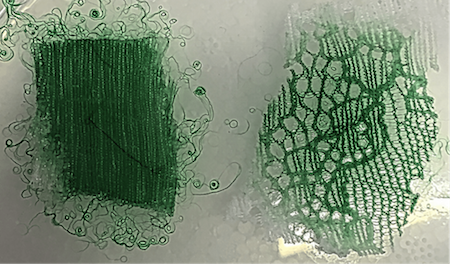Science Fiction
Dictionary
A B C D E F G H I J K L M N O P Q R S T U V W X Y Z
Fluorescent Bacteria Fashion

Victoria Geaney seeks to combine fashion, art, science and technology. She says “the work I produce may not always be wearable or even possible, but the idea and innovation is what I find interesting and is what I am passionate about.”

(Biomaterial fashioned from little more than sunlight and air)
Although purely conceptual, the collection of 2-D print design work explored the idea of fluorescent bacteria and its theoretical application on garments as a biological, glowing print. Aware that there are laws that disallow bacteria to be used in this way, Victoria admitted that “fabric that could be living and emitting light is very interesting!”More recently Victoria together with three other research students Wayne Binitie, Flora Bowden and Trent Kim Future, presented an interdisciplinary exhibition that takes inspiration from nature using non-traditional materials. Attending visitors were given the opportunity to be wowed by the project I mentioned earlier. Called Azzazel, the exhibition showed a collection of bacterial cellulose sculptures that included a dress made from Kishitanni, a photobacterium that is found deep in the ocean and glows a blue colour when alive.
Fans of science fiction may recall the biofabrics from J.G. Ballard's 1970 short story Say Goodbye to the Wind:
The racks of gowns itched and quivered, their colors running into blurred pools. One drawback of bio-fabrics is their extreme sensitivity. Bred originally from the gene stocks of delicate wisterias and mimosas, the woven yard have brought with them something of the vine's remarkable response to atmosphere and touch. The sudden movement of someone nearby, let alone of the wearer, brings an immediate reply from the nerve-like tissues. A dress can change its color and texture in a few seconds, becoming more decollete at the approach of an eager admirer, more formal at a chance meeting with a bank manager.This sensitivity to mood explains the real popularity of bio-fabrics. Clothes are no longer made from dead fibers of fixed color and texture that can approximate only crudely to the vagrant human figure, but from living tissues that adapt themselves to the contours and personality of the wearer. Other advantages are the continued growth of the materials, fed by the body odours and perspriration of the wearer, the sweet liqueurs distilled from her own pores, and the constant renewal of the fibers, repairing any faults or ladders and eliminating the need for washing.
Be sure to check out Ballard's related term inert-wear.
Via fashnerd.
Scroll down for more stories in the same category. (Story submitted 3/2/2017)
Follow this kind of news @Technovelgy.| Email | RSS | Blog It | Stumble | del.icio.us | Digg | Reddit |
Would
you like to contribute a story tip?
It's easy:
Get the URL of the story, and the related sf author, and add
it here.
Comment/Join discussion ( 0 )
Related News Stories - (" Clothing ")
iPhone Pocket All Sold Out!
'A long, strong, slender net...' - Margaret St. Clair, 1949.
Skip Movewear Arc'teryx AI Pants
'...the terrible Jovian gravity that made each movement an effort.' - Edmond Hamilon, 1930.
Kolors Virtual-Try-On Predicted, And TRIED, By Harry Harrison
'Bill blinked at his own face under the plumed helmet...' - Harry Harrison, 1965
Qore IcePlates Are Personal Cooling Suits
'... underneath they consisted of networks of cooling tubes against the skin.' - Neal Stephenson, 2021.
Technovelgy (that's tech-novel-gee!) is devoted to the creative science inventions and ideas of sf authors. Look for the Invention Category that interests you, the Glossary, the Invention Timeline, or see what's New.
Science Fiction
Timeline
1600-1899
1900-1939
1940's 1950's
1960's 1970's
1980's 1990's
2000's 2010's
Current News
iPhone Air Fulfils Jobs' Promise From 2007 - A Giant Screen!
'... oblongs were all over the floor and surfaces.'
ChatGPT Now Participates in Group Chats
'...the city was their laboratory in human psychology.'
iPhone Pocket All Sold Out!
'A long, strong, slender net...'
Did The Yautja Have These First?
What a marvel of ingenuity the little device was!
Jetson ONE Air Races Begin, Can Air Polo Be Far Behind?
'If you're one of those rarities who haven't attended a rocket-polo "carnage", let me tell you it's a colorful affair.'
Will Space Stations Have Large Interior Spaces Again?
'They filed clumsily into the battleroom, like children in a swimming pool for the first time, clinging to the handholds along the side.'
Mornine Sales Robot
'Robot-salesmen were everywhere, gesturing...'
Bipedal Robot Floats Gently While Walking
'a walking balloon proceeded with long strides of its aluminum legs...'
Musk Idea Of Cars Talking To Each Other Predicted 70 Years Ago
'My cars talk to one another.'
Elegant Bivouac Shelter Produces Water And Electricity
'There was nowhere on the planet where science and technology could not provide one with a comfortable home...'
X-Control Janus-1 A Suitcase Aircraft
'You will notice that it... fits the suitcase nicely.'
'AI Assistants' Are Actually Less Reliable For News
'Most men updated their PIP on New Year's Day...'
YES!! Remote Teleoperated Robots predicted by Technovelgy!
'...a misshapen, many-tentacled thing about twice the size of a man.'
Will Robots Ever Fold Landry?
Where have you gone, Mrs. Robinson?
Will AIs Give Better Results If You're Rude To Them?
'I said, "Listen up, motherf*cker.'
Cybertruck Robotic Arm F10 Drone Launch!
Drone away!
